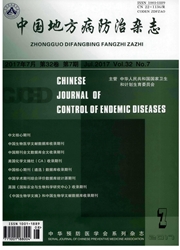

 中文摘要:
中文摘要:
目的了解不同水碘地区孕妇碘营养状况,探索其影响因素,为孕妇孕期补碘提供科学依据。方法根据近年全国水源性高碘地区调查及全国碘缺乏病监测结果,适碘地区选择山西省汾阳市贾家庄乡和阳城乡(水碘50-100μg/L,对照组);高碘地区选择山西省汾阳市冀村镇和平遥县(水碘≥300μg/L),分别选择符合纳入条件(近半月内未服用富碘药物、无家族甲状腺疾病遗传史、排除先天性甲状腺疾病等)孕妇,其中适碘地区75例,高碘地区83例。对水碘、尿碘及游离三碘甲状腺原氨酸(free triiodothyronine,FT3)、游离四碘甲状腺原氨酸(free thyroxin,FT4)、促甲状腺素(thyroidstimulating hormone,TSH)、甲状腺球蛋白自身抗体(thyroglobulin antibody,TGAb)和甲状腺过氧化酶自身抗体(thyroid peroxidase antibody,TPOAb)等指标进行检测分析。结果调查显示水碘中位数分别为,适碘地区57.5μg/L、高碘地区464.8μg/L,高碘地区水碘含量高于适碘地区,差异有统计学意义(z=-2.852,P=0.004);适碘地区孕妇尿碘中位数(median urinary iodine,MUI)为223.38μg/L,总体处于适宜水平;高碘地区孕妇尿碘水平为814.05μg/L,总体偏高,且高碘地区孕妇尿碘水平高于适碘地区(z=-7.716,P=0.000);高碘地区孕妇TSH水平高于适碘地区(z=-10.416,P=0.000);甲状腺疾病患病率高于适碘地区孕妇,差异无统计学意义(χ2=3.801,P=0.051)。Logistic回归分析显示,孕妇在孕期每周食用肉类2-3次发生碘营养不足的可能性较小(OR=0.092,95%CI=0.012-0.728,p=0.024);孕期每周食用牛奶4次以上的孕妇发生碘营养超过适宜量的可能性大(OR=8.624,95%CI=1.727-43.069,P=0.009);年龄较大的孕妇发生碘营养水平超适宜的可能性较小(OR=0.731,95%CI=0.558-0.958,P=0.023);居住在高水碘地区、在本地居住5年以上均是孕妇发生碘营养碘过量的危险因素(OR=50.650,95%CI=10.450-245.496,P=0.000;OR
 英文摘要:
英文摘要:
Objective To explore the iodine nutrition and its influencing factors in pregnant women with different iodine intakes,and provide scientific evidence for iodine intake among pregnant women. Methods Villages for survey were selected based on the national surveillance data on water- borne iodine- excess areas, along with historical iodine deficiency disorders( IDD) surveillance data obtained in recent years. Jiajiazhuang township and Yangcheng township, both located in Fenyang city from Shanxi province, were selected as areas where residents have sufficient iodine nutrition( ≥50 μg / L median water iodine≤100 μg / L, the control group). Jicun township and Pingyao township( Fenyang city of Shanxi province) were selected as areas with high iodine water content( median water iodine≥300 μg / L). A total of 158 pregnant women( including 75 and 83 subjects from iodine sufficient and excess regions) were recruited, excluding those taking anti- thyroid drugs within half a month of the study, with a family history of thyroid disease, and elimination of congenital thyroid disease. The following indicators were adopted to assess iodine status, median urinary iodine concentration( MUI), median water iodine( MWI), thyroid stimulating hormone( TSH), free triiodothyronine( FT3), free thyroxin( FT4), thyroglobulin antibody( TGAb) and thyroid peroxidase antibody( TPOAb) were included as indicators for testing. Results The median water iodine content was 57. 5 μg / L and 464. 8 μg / L for the iodine sufficient and excess groups. Water iodine content varied significantly between the two groups( z =- 2. 852, P = 0. 004). MUI value of pregnant women was 223. 38 μg / L for the iodine sufficient group, which was at the appropriate level as a whole. MUI value was 814.05 μg / L for the excess group. Compared to the iodine sufficient group, MUI values were significantly higher in the iodine excess group( z =- 7. 716, P = 0. 000). We observed that median TSH concentrations
 同期刊论文项目
同期刊论文项目
 同项目期刊论文
同项目期刊论文
 期刊信息
期刊信息
